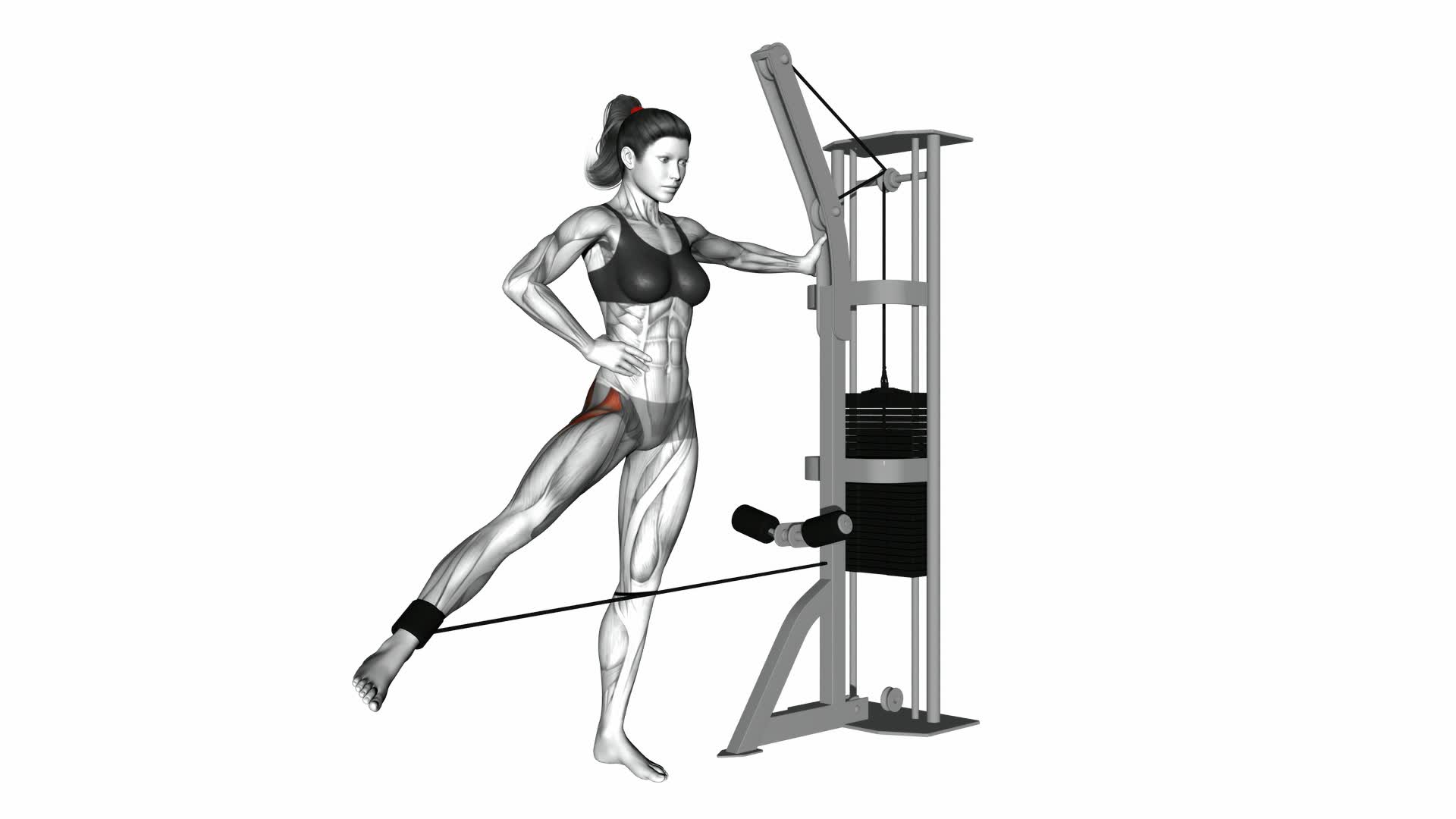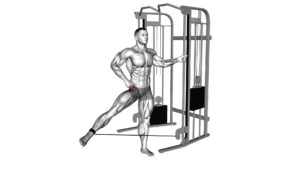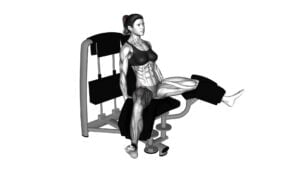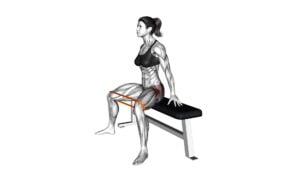Cable Hip Abduction (Version 2) – Video Exercise Guide & Tips

Looking to strengthen your hip muscles? Check out this video exercise guide for Cable Hip Abduction (Version 2).
Watch This Exercise Video
With step-by-step instructions and helpful tips, you'll learn how to properly perform this exercise using cable equipment. Avoid common mistakes and get the most out of your workout with variations and modifications.
Whether you're a beginner or an experienced fitness enthusiast, this guide will help you achieve your goals and improve your hip strength.
Let's get started!
Key Takeaways
- Cable hip abduction strengthens the outer thigh muscles and improves hip stability and balance.
- It reduces the risk of hip pain and knee instability, as well as alleviates lower back pain.
- Proper form and technique are crucial, including maintaining a neutral spine, avoiding leaning or tilting, and engaging the core.
- Incorporating variations, modifications, and rest and recovery techniques are important for preventing plateaus, reducing the risk of injury, and achieving optimal results.
Benefits of Cable Hip Abduction
To experience the benefits of cable hip abduction, you should incorporate this exercise into your fitness routine. Cable hip abduction exercises offer numerous benefits for your lower body strength and stability. This exercise specifically targets the muscles of the outer thighs, including the gluteus medius and minimus. By engaging these muscles, cable hip abduction helps to improve hip stability and balance, reducing the risk of injuries such as hip pain and knee instability.
In addition to strengthening the outer thigh muscles, cable hip abduction also targets the hip abductor muscles, which are responsible for moving your leg away from the center of your body. By strengthening these muscles, you can improve your overall hip strength and stability, which is essential for activities like running, walking, and jumping.
Another benefit of cable hip abduction exercises is that they can help to improve your overall body posture. By strengthening the gluteus medius and minimus muscles, you can enhance the alignment of your hips, which can have a positive impact on your overall posture. This can help to alleviate lower back pain and improve your overall movement mechanics.
Equipment and Setup
To set up for cable hip abduction exercises, you'll need a cable machine and an ankle attachment. The cable machine provides the resistance needed to strengthen your hip abductor muscles, while the ankle attachment allows you to secure your leg and perform the exercise effectively. Make sure the cable machine is adjusted to the appropriate height for your height and comfort.
Attach the ankle attachment to your ankle and stand facing the machine. Position yourself a few feet away from the machine, with your feet shoulder-width apart. Keep your core engaged and maintain a slight bend in your knees throughout the exercise. This setup will ensure that you're in the correct starting position for cable hip abduction exercises.
Now that you have the equipment and setup ready, it's time to focus on proper form and technique. By maintaining a stable and controlled movement, you can maximize the benefits of this exercise and minimize the risk of injury.
Proper Form and Technique
Are you performing cable hip abduction exercises with proper form and technique?
Proper form and technique are essential when performing any exercise, including cable hip abduction. Not only does it ensure that you're targeting the correct muscles, but it also helps prevent injuries and allows for optimal muscle engagement.
To maintain proper form during cable hip abduction, start by standing tall with your feet shoulder-width apart and your core engaged. Attach the ankle cuff to your ankle, making sure it's secure.
Begin the movement by abducting your leg away from your body, keeping your knee straight and your foot flexed. Avoid leaning or tilting your body to the side as this can compromise your form and lead to unnecessary strain on your lower back.
Additionally, it's important to listen to your body and give it adequate rest and recovery. Overtraining can increase the risk of injury and hinder your progress.
Remember to always consult with a qualified fitness professional before starting any new exercise program.
Variations and Modifications
Continue targeting the correct muscles and preventing injuries by exploring variations and modifications for cable hip abduction exercises. By incorporating variations and modifications into your routine, you can add variety to your workouts and challenge your muscles in different ways. This can help prevent plateaus and keep your workouts interesting and engaging.
One variation you can try is the standing cable hip abduction. Instead of lying on your side, stand facing the cable machine and attach the ankle strap to your ankle. With a slight bend in your knee, lift your leg out to the side, focusing on using your hip muscles to perform the movement. This variation allows you to work on stability and balance, as well as targeting the same muscles as the traditional cable hip abduction exercise.
Another modification you can make is adjusting the weight or resistance used. Increasing the weight or resistance can make the exercise more challenging, while decreasing it can be beneficial for beginners or individuals with limited mobility.
Remember to always listen to your body and adjust the exercises according to your fitness level and goals. Incorporating variations and modifications into your cable hip abduction exercises can help you continue to progress and achieve optimal results.
Common Mistakes to Avoid
When performing cable hip abduction exercises, it's important to be mindful of your form to maximize the effectiveness of the exercise and prevent injury.
A common mistake to avoid is using too much weight, which can lead to improper form and strain on your muscles and joints.
Additionally, make sure to maintain control throughout the movement and avoid swinging or jerking motions.
Proper Form Tips
To ensure proper form during Cable Hip Abduction (Version 2), it's important that you maintain a stable core.
This exercise offers numerous benefits for your hips, such as strengthening the gluteus medius and minimus muscles, improving hip stability, and increasing overall lower body strength.
However, there are some common mistakes to avoid to maximize the effectiveness of this exercise.
One mistake is using too much weight, which can compromise your form and potentially lead to injury.
Another mistake is allowing your upper body to lean forward or backward, instead of maintaining an upright posture.
Additionally, avoid using momentum to swing your leg outwards, as this reduces the engagement of the target muscles.
Injury Prevention Techniques
Avoiding common mistakes is crucial for injury prevention during Cable Hip Abduction (Version 2). To ensure a safe and effective workout, it's important to incorporate injury prevention exercises and pre-workout warm-up techniques.
Here are some tips to help you avoid common mistakes and reduce the risk of injury:
- Warm-up properly before starting the Cable Hip Abduction exercise:
- Perform dynamic stretches to activate the muscles involved in hip abduction.
- Incorporate light cardio exercises, such as jogging or cycling, to increase blood flow and warm-up the entire body.
- Maintain proper form throughout the exercise:
- Keep your core engaged and maintain a neutral spine.
- Avoid excessive swinging or jerking motions that can strain the muscles and joints.
Tips for Getting the Most Out of Your Workout
To get the most out of your workout, it's crucial to focus on proper form. This ensures that you're targeting the right muscles and minimizing the risk of injury.
Additionally, don't forget the importance of rest and recovery. Giving your body time to rest and repair is essential for muscle growth and overall progress.
Proper Form Importance
Get the most out of your workout by focusing on proper form. The importance of technique can't be overstated when it comes to maximizing your results and minimizing the risk of injury. Here are some common form mistakes to avoid:
- Poor posture: Keep your back straight and shoulders relaxed throughout the exercise.
- Using momentum: Avoid swinging or jerking movements by maintaining control and engaging the targeted muscles.
By paying attention to these details and performing the exercise with proper form, you'll optimize the effectiveness of each repetition and ensure that you're targeting the intended muscles. Remember, quality over quantity is key in achieving your fitness goals.
Now that you understand the importance of proper form, let's move on to the next crucial aspect of your workout: rest and recovery.
Rest and Recovery
For optimal results, prioritize rest and recovery after your workout. Rest and recovery are essential for your body to repair and rebuild itself, leading to improved performance and injury prevention.
Neglecting rest can lead to overtraining, which can result in decreased performance, increased risk of injury, and burnout. To maximize the benefits of your workout, make sure to incorporate rest days into your routine. This allows your muscles, tendons, and ligaments to recover and adapt to the stress of exercise.
Additionally, proper nutrition and hydration are crucial for effective recovery. Make sure to consume a balanced diet that includes protein, carbohydrates, and healthy fats to support muscle repair and replenish energy stores.
Adequate sleep is also vital for rest and recovery, as it allows your body to repair and rejuvenate itself.
Frequently Asked Questions
How Often Should I Include Cable Hip Abduction Exercises in My Workout Routine?
Including cable hip abduction exercises in your workout routine can be beneficial for strengthening and toning your hip muscles. These exercises target the outer hip muscles, helping to improve stability and enhance overall lower body strength.
There are various variations of cable hip abduction exercises that you can incorporate into your routine, such as standing or lying variations. It's recommended to perform these exercises a few times a week, while allowing for proper rest and recovery.
Can Cable Hip Abduction Exercises Help Improve My Balance and Stability?
Cable hip abduction exercises can be beneficial for improving your balance and stability. By targeting the hip muscles, these exercises strengthen the muscles responsible for maintaining balance.
This increased strength can help you feel more stable and grounded during everyday activities. Incorporating cable hip abduction exercises into your workout routine on a regular basis can contribute to improved overall balance and stability.
Are There Any Precautions or Contraindications for Performing Cable Hip Abduction Exercises?
Before starting any exercise, it's important to be aware of any precautions or contraindications.
When it comes to cable hip abduction exercises, there are a few things to consider. It's recommended to avoid this exercise if you have any hip or lower back injuries. Additionally, if you experience pain or discomfort during the exercise, it's best to stop and consult with a medical professional.
Always listen to your body and prioritize your safety when performing any exercise.
Can Cable Hip Abduction Exercises Help Reduce Hip Pain or Improve Hip Mobility?
Cable hip abduction exercises can be beneficial in reducing hip pain and improving hip mobility. By targeting the muscles around the hip joint, these exercises can help strengthen and stabilize the area, leading to a reduction in pain.
Additionally, the controlled movements involved in cable hip abduction exercises can help improve the range of motion in your hips, allowing for better mobility and flexibility.
Incorporating these exercises into your routine can contribute to overall hip health and function.
Are There Any Specific Recommendations for the Amount of Resistance or Weight to Use During Cable Hip Abduction Exercises?
For cable hip abduction exercises, there are specific recommendations for the amount of resistance or weight to use. It's important to start with a weight that challenges you but still allows for proper form. Gradually increase the resistance as you become stronger and more comfortable with the exercise.
Consulting with a fitness professional can help determine the appropriate weight for your current fitness level and goals. Remember to listen to your body and make adjustments as needed.
Conclusion
In conclusion, cable hip abduction is a highly effective exercise for targeting and strengthening the hip muscles.
By using the proper equipment and maintaining proper form and technique, you can maximize the benefits of this exercise.
Remember to avoid common mistakes and make necessary modifications to suit your fitness level.
By following these tips, you can ensure a successful and efficient workout that will help you achieve your fitness goals.

Author
Years ago, the spark of my life’s passion ignited in my mind the moment I stepped into the local gym for the first time. The inaugural bead of perspiration, the initial endeavor, the very first surge of endorphins, and a sense of pride that washed over me post-workout marked the beginning of my deep-seated interest in strength sports, fitness, and sports nutrition. This very curiosity blossomed rapidly into a profound fascination, propelling me to earn a Master’s degree in Physical Education from the Academy of Physical Education in Krakow, followed by a Sports Manager diploma from the Jagiellonian University. My journey of growth led me to gain more specialized qualifications, such as being a certified personal trainer with a focus on sports dietetics, a lifeguard, and an instructor for wellness and corrective gymnastics. Theoretical knowledge paired seamlessly with practical experience, reinforcing my belief that the transformation of individuals under my guidance was also a reflection of my personal growth. This belief holds true even today. Each day, I strive to push the boundaries and explore new realms. These realms gently elevate me to greater heights. The unique combination of passion for my field and the continuous quest for growth fuels my drive to break new ground.







